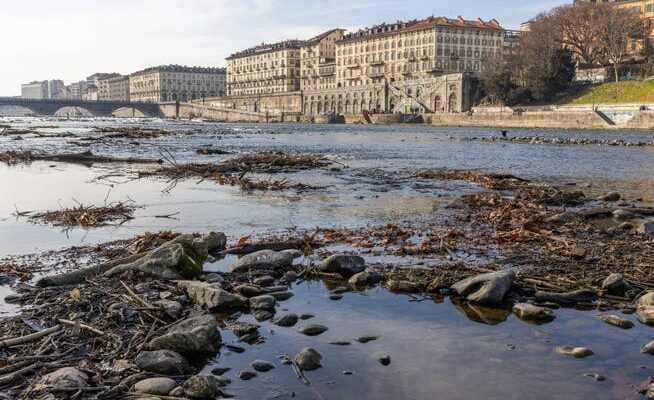The Po River has not been as low as it has been in recent months for decades. The drought in northern Italy has lasted for a hundred days. This could have far-reaching consequences for agriculture.
The level of the Po – here in Turin – is well below normal.
For about a hundred days, there has been no rainfall in northern Italy, which is otherwise usual for the season. The last time it rained was in mid-February, but the event was not enough to replenish the water resources. The Po Valley is suffering from drought: the level of the Po River has fallen well below normal. Rivers that flow into the Po also have a lack of water. The Trebbia, Secchia and Reno tributaries have reached their lowest levels for winter months since 1972. Dora Baltea, Adda and Tessin recorded a 75 percent decrease in the amount of water. Lake Como and Lake Langen are also affected.
For the past thirty days, the great river’s discharge has continued to decrease steadily, according to the Po River Basin Authority. The most affected section is at Piacenza, where the flow rate is only 260 cubic meters per second. The reduction corresponds to a deficit of 66 percent. The authority speaks of an “extreme hydrological drought”. The situation brings back bad memories of the summer of 2017 when Italy was struggling with a severe drought.
The situation is also critical for drinking water sources, particularly in Piedmont and the Apennines. In some areas there is no drinking water. In villages in the lower Piedmont, the civil defense had to distribute drinking water by tanker.
Concerns about water reserves
“The drought in the Po region is becoming more and more severe,” the Po River Basin Authority warned. The increased winter temperatures, the wind and the lack of snow – all of this harbors risks for agriculture and energy production from hydropower. In Piedmont it will be difficult to start the irrigation season. The problems would slowly spread towards the Po Delta. The authority calls for an exemption for water abstraction for the benefit of agriculture and hydroelectric power generation.
The Farmers’ Union Coldiretti warns in one communique warns that “significant economic losses” are to be expected in the water-dependent sectors. The drought is threatening a third of national agricultural production, including tomatoes, fruits, vegetables, wheat, half of livestock around Parma, in the Emilia-Romagna region. Water rationing and limited irrigation threatened.
It didn’t rain in March either, according to Coldiretti. The association demands that a state of emergency be declared for the Piedmont region. The situation is getting worse by the day and the harvests have already been affected, it is quoted as saying the Italian news agency Ansa Representatives of Coldiretti. The growth of barley, wheat and ryegrass can be affected. The development of the forage meadows is also worrying. The sowing of corn, which is imminent, could be problematic.
Coldiretti’s concerns are about the sinking of the water table, the flow rate of the watercourses and the lack of water reserves. The association demands that the water be used more efficiently. In agriculture, systems with low water consumption are to be promoted. In general, Coldiretti wants to do more to combat water wastage.
The Ministry of the Environment has reacted to the problem: According to Ansa, it has released 1 billion euros for projects in the irrigation sector and 700 million euros for the construction of new reservoirs. The water availability in the region is continuously recorded. According to initial estimates, the damage to production caused by the drought amounts to 50 million euros.
One of the driest winters in decades
The reason for the lack of water is a special winter: The Regional Office for Environmental Protection in Lombardy (Arpa Lombardia) speaks of the mildest and driest winter in Lombardy, Piedmont and Ticino in the past 30 years. According to local authorities, the average rainfall deficit is minus 65 percent compared to the 1991 climate norm by 2020.
The UN Climate Council IPCC warned in its new report at the beginning of the month that extreme weather events are not only becoming more frequent, but also more intense. According to this, floods will also increase, for example, because the soil, which has been marked by drought, will have trouble absorbing water. To ensure that agriculture does not have to reckon with significant losses, the IPCC proposes adjustments to cultivation methods and other crops and animals.
No major changes are forecast for the coming period. Italian meteorologists have, however, promised a small ray of hope: towards the end of March and beginning of April it could rain in many regions of the country, in the north it could even snow more heavily than it has for a long time.
